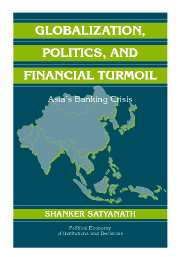Book contents
- Frontmatter
- Contents
- Figures and Tables
- Preface
- GLOBALIZATION, POLITICS, AND FINANCIAL TURMOIL
- 1 Introduction
- 2 Bank Regulation in the Debate over Capital Flow Liberalization
- 3 The Signaling Argument
- 4 Incredible Signaling in Democracies: The Cases of Thailand, South Korea, and the Philippines
- 5 Unorthodox Solutions to the Signaling Problem: The Cases of Malaysia and Indonesia
- 6 Orthodox Solutions to the Signaling Problem: The Cases of Singapore and Hong Kong
- 7 Some Concluding Remarks
- Appendix I The World Bank's Evaluation of Bank Regulatory Environments
- Appendix II Verbal Description of the Equilibrium with Two Signalers
- Appendix III Formal Proof of Equilibrium with Two Signalers
- Bibliography
- Interviews by the Author
- Index
- POLITICAL ECONOMY OF INSTITUTIONS AND DECISIONS
Appendix I - The World Bank's Evaluation of Bank Regulatory Environments
Published online by Cambridge University Press: 24 July 2009
- Frontmatter
- Contents
- Figures and Tables
- Preface
- GLOBALIZATION, POLITICS, AND FINANCIAL TURMOIL
- 1 Introduction
- 2 Bank Regulation in the Debate over Capital Flow Liberalization
- 3 The Signaling Argument
- 4 Incredible Signaling in Democracies: The Cases of Thailand, South Korea, and the Philippines
- 5 Unorthodox Solutions to the Signaling Problem: The Cases of Malaysia and Indonesia
- 6 Orthodox Solutions to the Signaling Problem: The Cases of Singapore and Hong Kong
- 7 Some Concluding Remarks
- Appendix I The World Bank's Evaluation of Bank Regulatory Environments
- Appendix II Verbal Description of the Equilibrium with Two Signalers
- Appendix III Formal Proof of Equilibrium with Two Signalers
- Bibliography
- Interviews by the Author
- Index
- POLITICAL ECONOMY OF INSTITUTIONS AND DECISIONS
Summary
In 1997, prior to the implementation of post-crisis reforms, the World Bank evaluated the bank regulatory environments of twelve countries on six criteria known as CAMELOT: capitalization, loan classification, management, liquidity, operating environment, and transparency. The countries were rank ordered in each of these areas, and their rank scores were added up to yield an overall score. Countries were then assigned to five different categories of stringency based on the clustering of points, with the top two categories being indicative of stringent regulation. Of the twelve countries, seven were the Asian countries with liberal capital flows that are considered in this book, while the remaining five were Latin American countries. Table A.1 shows how these countries ranked on each of the components of regulation. Note that of the two democracies that had stringent bank regulatory environments, the commitment of one (Argentina) collapsed in the late 1990s. As for the second, Chile, the country's regulatory record was achieved under a regime with substantial capital controls, meaning that we have no way of knowing if it would have been robust to massive unrestricted capital inflows. (Chile's score on the IMF's capital controls index was 0.89 out of a possible 1 in 1996, with 1 indicating a closed environment. By way of comparison, the most closed economy of the ones studied in this book was South Korea, with a score of 0.7.)
A detailed description of each of the regulatory measures is available in Caprio (1998).
- Type
- Chapter
- Information
- Globalization, Politics, and Financial TurmoilAsia's Banking Crisis, pp. 135 - 136Publisher: Cambridge University PressPrint publication year: 2005



